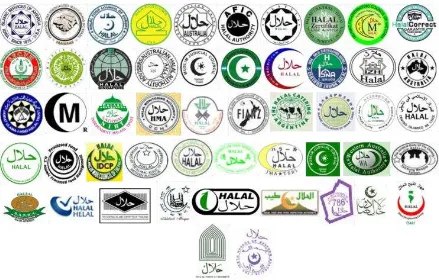Faculty of Electronics and Computer Engineering
ACCURATE REAL TIME DETECTION FOR HALAL LOGO BASED
ON FOURIER MAGNITUDE METHOD
Nurul Atiqah Binti Ismail
MSc. in Electronic Engineering
ACCURATE REAL TIME DETECTION FOR HALAL LOGO BASED ON FOURIER MAGNITUDE METHOD
NURUL ATIQAH BINTI ISMAIL
A thesis submitted
in fulfillment of requirements for the degree of Master of Science in Electronic Engineering
Faculty of Electronics and Computer Engineering
UNIVERSITI TEKNIKAL MALAYSIA MELAKA
DECLARATION
I declare that this thesis entitle “Accurate Real Time Detection For Halal Logo Based On Fourier Magnitude Method” is the result of my own research except as cited in the references. The thesis has not been accepted for any degree and is not concurrently submitted in candidature of any other degree.
Signature : ...
Name : ...
APPROVAL
I hereby declare that I have read this thesis and in my opinion this thesis is sufficient in terms of scope and quality for the award of Master of Science in Electronic Engineering.
Signature : ...
Supervisor Name : ...
i ABSTRACT
ii
ABSTRAK
iii
ACKNOWLEDGEMENTS
First of all, I would like to express my appreciation and gratitude to everyone in completing this thesis. It was pleasure to study under Engr. Khairul Muzzammil bin Saipullah supervision. It is not enough to say that thank you very much for his guidance to help me to achieve my goal. Without his valuable support, my thesis would not have been possible. I would like to express my sincere thanks to my supervisor Dr. Soo Yew Guan for his advices, consistent encouragement and understanding throughout my research. Furthermore, I would like to express my appreciation to all my fellow friends, lecturer and staff at the FKEKK faculty of University Teknikal Malaysia Melaka (UTeM) who have given me help and support during this research.
iv
1.2 Object Detection on Smartphone 6
1.3 Problem Statement 7
1.4 Objectives 8
1.5 Scope of Works 9
1.6 Contribution
1.7 Organization of Thesis 10
2. LITERATURE REVIEW 11
2.1 Introduction 11
2.2 Object Detection 11
2.3 Logo Detection 13
2.3.1 Key-point Based Object Detection 15
2.3.1.1 Scale Invariant Feature Transform 16 2.3.1.2 Speed up Robust Feature (SURF) 23 2.3.1.3 Feature from Accelerate Segment Test (FAST) 26
2.3.1.4 Good Feature to Track (GFTT) 29
2.3.1.5 Maximally Stable Extrema Regions (MSER) 30 2.3.1.6 Oriented FAST and Rotated BRIEF (ORB) 31 2.3.1.7 Center Surrounded Extrama (CenSurE) 32
2.4 Template Matching 33
2.4.1 Matching the Template 34
2.5 Histogram of Oriented Gardients(HOG) 36
2.6 Moment Invariants 39
v
3.3 Object Detection Performance in Android Platform 51
3.3.1 Speed 55
3.3.2 Number of Key-point 55
3.3.3 Repeatability 55
3.3.4 Robustness 57
3.4 JAKIM Halal Logo Detection and Classification 59 3.4.1 Template Matching Based Recognition 62
3.4.2 Template Matching Algorithm 65
3.5 Fractionalize Principle Magnitude (FPM) 69
3.5.1 FPM Recognition and Classification 78
3.6 Android Framework 80
3.6.1 Android and JAVA Native Interface 82
3.7 Summary 85
4. RESULTS AND DISCUSSIONS 86
4.1 Introduction 86
4.2 Result of Object Detection Performance in Android Smartphone 86
4.2.1 Speed 87
4.2.2 Number of Feature 88
4.2.3 Repeatability 89
4.2.4 Robustness 90
4.3 Performance Evaluation of Halal Logo Detection and Classification 95 4.4 Evaluation of FPM in JAKIM Approved Halal Logo Classification 99
4.4.1 Extension Evaluation of FPM 103
4.5 Summary 103
5. CONCLUSION AND FUTURE WORK 104
5.1 Conclusion 104
5.2 Future Work 107
vi
LIST OF TABLES
TABLE TITLE PAGE
2.1 RGB color bars 26
3.1 The true positive with threshold 100% 102
4.1 Time classification of Halal logo 117
4.2 The false positive with threshold 100% 119
4.3 The true positive with threshold 100% 120
vii
2.1 The face detection (a) The original of Lena image, (b) The red box show the detection area (Gonzalez et. al., 2002)
12
2.2 The corner process (a) The original image, (b) The detected corners are surrounded by a small red circle (Jeong, K. and Moon, H., 2011)
15
2.3 The SIFT method step 17
2.4 The simple image 18
2.5 Gaussian pyramid 19
2.6 The blurred image with different scale and computational using different of gradient pyramid (A. Vedaldi, 2007)
20
2.7 Local extrema detection 20
2.8 Feature vector of key-point 22
2.9 The discrete and crop Gaussian second order derivative for y-direction (Lyy) and xy-y-direction (Lxy) in the box filter 9x9 kernel illustrated. The grey regions in the box filter are equal to zero value
viii
2.12 The location of corner position in the image (Tomasi, 1994) 30 2.13 The generic center-surround bi-level filters approximating the
Laplacian
32
2.14 Template matching, f<g 34
2.15 (a) The original image, (b) The template, (c) The labeled template
2.17 The static HoG feature extraction 38
2.18 Wavelet decomposition sub-bands 42
2.19 The concept of Fourier Transform 43
2.20 1D Fourier Transform 45
3.1 The methodology flowchart of this research work 50
3.2 JAKIM Halal logo as a reference logo 52
3.3 Flow chart of JAKIM Halal logo detection algorithm 53
3.4 The illustration of the experiment 54
3.5 The image with angle orientation for -30° and +30°, the images with -10cm and +10cm distance
58
ix Template 4 and (d) Template 5
67
3.12 The detection template area of Halal logo image 69
3.13 The main layout of the application 70
3.14 The flow of the software system 71
3.15 The FPM algorithm 73
3.16 The flow of the FPM process 74
3.17 The example of Halal logo in different class 74
3.18 The Halal logo is divided into 9 blocks 75
3.19 The graphical illustration of converting 2D image to a single array 76
3.20 The 3x3 window of an original image 77
3.21 The 3x3 window of Fourier transformed image 77
3.22 The 2D image is converted into a 1D array 79
3.23 The real and imaginary output from Fourier Transform 80
3.24 Four principle magnitude is selected 80
3.25 The overall process of transformation from 2D image into 1D Fourier transform
81
3.26 The 5-fold cross validation 83
3.27 The illustration concept of the steps of k-fold cross-validation 83
x
3.29 The role of JNI Android platform 88
4.1 The result of FAST algorithm 87
4.2 Frame processing for seven object detection methods 88 4.3 Feature counts for seven object detection methods 89 4.4 The standard deviation of RER for seven object detection methods 90 4.5 The RER compared to the normal light of each object detection
method in three different illumination; (a) Natural light, (b) Incandescent light and (c) Dim light
92
4.6 The RER of the object detection methods with respect to different distance from the object; (a) +10cm and (b) -10cm
93
4.7 The RER of the object detection methods with respect to different viewpoint from the object; (a) +30° and (b) -30°
94
4.8 The result of the approved Halal logo by JAKIM is displayed on the screen
95
4.9 The result of the fake Halal logo is displayed on the screen 96 4.10 The example of Halal logo taking from the Smartphone (a) The Halal
logo by JAKIM and (b) The fake Halal logo
96
xi
LIST OF ABBREVIATIONS
AOT - Accuracy Over Time
CMYK - Cyan, Magenta, Yellow, And Key (Black)
CenSurE - Center Surrounded Extrema
DoG - Difference Of Gaussian
EBR - Edge-Based Region
EDH - Edge Directional Histogram
FAST - Features from Accelerated Segment Test
FLANN - Fast Library for Approximate Nearest Neighbors
FPM - Fractionalized Principle Magnitude
FN - False Negative
HSV - Hue-Saturation-Value
IBR - Intensity Extremal-Based Region
JAKIM - Jabatan Agama Kemajuan Islam Malaysia
xii JVM - JAVA Virtual Machine
JRE - JAVA Runtime Environment
LL - Low-Low
LH - Low-High
Mag - Magnitude
MAIN - Majlis Agama Islam Negeri
MPEG - Moving Picture Experts Group
MSER - Maximally-Stable Extremal Region Extractor
MSE - Mean Squared Error
NCC - Normalized Cross Correlation
NDK - Native Development Kit
OS - Operating System
RER - Repeatability Error Rate
RGB - Red Gray Blue
SAD - Sum of Absolute Differences
SDK - Software Development Kit
SIFT - Scale Invariant Feature Transform
SSD - Squared Different Matrix
SuRF - Speeded-Up Feature Transform Discrete
SVM - Support Vector Machine
TN - True Negative
TP - True Positive
WCH - Wavelet Co-occurrence Histogram
xiii
LIST OF SYMBOLS
log - Logarithm dB - Decibel
xiv
LIST OF PUBLICATIONS
The research papers produced and published during the course of this research are as follows:
1. Khairul Muzzammil Saipullah, Nurul Atiqah Ismail and Yewguan Soo, 2013. Feature Extraction method for Classification of Approved Halal Logo in Malaysia using Fractionalized Principle Magnitude. Journal of Engineering Management Reviews (EMR), 2(2), pp. 36-44.
2. Khairul Muzzammil Saipullah, Nurul Atiqah Ismail, Ammar Anuar, Nuraishah Sarimin, 2012. Comparison Of Feature Extractors For Real-Time Object Detection On Android Smartphone, Journal of Theoretical and Applied Information Technology (JATIT), 47(1), pp.135-142. (Scopus)
3. Khairul Muzzammil Saipullah, Nurul Atiqah Ismail and Yewguan Soo, 2012. Feature Extractor for the Classification of Approved Halal Logo in Malaysia,
2012 IEEE Conference on International Conference on Control System, Computing and Engineering (ICCSCE), pp. 495- 500. (Scopus)
4. Khairul Muzzammil Saipullah, Ammar Anuar, and Nurul Atiqah Ismail, 2012.
JAKIM’S Halal Logo Recognition System Based on Android Smartphone,
xv
CHAPTER 1
INTRODUCTION
1.1 Background
Object detection has a lot of usages and importance to our life. Basically, object detection is used to understand the meaning or content of an image and it also can be used to identify and classify logo. A logo is a symbol that represents a company or product and shows the strength and value of a company or product. Certain companies spend a lot of money to come up with the right logo that able to represent their identity and it also must be simple so that it can be remembered and identified by consumer easily. Therefore, each logo has its own intellectual property and any plagiarism will be sued by the responsible organization.
The challenge in recognition a logo involves the sensitivity of the recognition regarding to the variation of size, background objects, orientations and lighting conditions of the logo that will significantly affect the recognition result. The lighting condition plays the main role in logo recognition where the changes of light will affect the RGB value of each pixel in the logo. Therefore, only a carefully constructed logo recognition method that considers all of the sensitive changes can achieve good logo recognition performance.
2
of Halal verifications and it needs to be requested by product owners, however the misused of the Halal logo by the irresponsible traders concerns the Muslim consumers. Other than Malaysian approved Halal logo, Department of Islamic Development Malaysia also approve others 50 Halal logo issued by 52 Muslim associations around the world. The only way to verify the Halal status of these foreign Halal products is by identifying their Halal logos. Current method to verify Halal status is by using short message service (SMS) and smartphone application. However, this system only verified the products that have Halal status in Malaysia and not for those Halal registered in other Muslim countries.
The main purpose of this thesis is to recognize the whole 50 Halal logos approved by Department of Islamic Development Malaysia and to perform Halal logo recognition on the Android smartphone. The smartphone is believed to be the fastest way to verify Halal product and most consumers have their own smartphone. A smartphone is built with advanced computing hardware compared to standard mobile phone. By implementing Halal logo recognition on the smartphone, the user can verify the Halal logo during their shopping. The detection method of Halal logo needs to be simple and accurate so that it can be embedded in Smartphone and can be used by Muslim consumers to recognize the Halal logo.
3
get confused in remembering all the logos. Therefore, this research was carried out to facilitate the Muslim consumers in Malaysia in identifying Halal products.
Figure 1.1: The example of Halal logo in the database
As the motivation of this problem, this research can be used to help users in the classification of the approved Halal logo. Since the logo can be differentiated using its visual information, the classification can be done using object detection and recognition method. From the Department of Islamic Development Malaysia website, the entire Halal product ingredients are permitted under Muslim law and also fulfill the following requirement;
4
2. The product or foods are free from any Najs (unclean) according to the Muslim law, is safe and not harmful.
3. The product is free from any part of the human body.
4. All the packaging process or manufactured equipment is not contaminated with the Najs according to the Muslim law.
5. During the preparation, process or packaging does not in contact or near with any food that does not meet the requirement or any substance will be considered impure by Islamic law (JAKIM, 2011).
The JAKIM’s Halal logo is shown in Figure 1.2 and the samples of fake Halal logos are shown in Figure 1.3. The Halal logo contains eight cusp stars at the center of a circle. At the center of the logo, there is ‘Halal’ word written in Arabic and Roman. At the top and bottom of the circle there is ‘MALAYSIA’ word written in both, Arabic and Roman. The word ‘Halal’ at the center is separated between two small stars.
5
Figure 1.3: The fake Halal logo
Due to variety of Halal logo issue, a new method needs to be developed to differentiate the JAKIM Halal logo with the fake Halal logo. This method must be simple and efficient so that it can be embedded in smartphone and can easily be applied by the Muslim consumers when they are buying products. With appropriate object detection method, this goal can be achieved.


